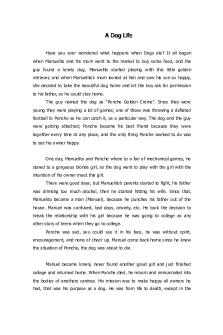A dark brown dog Stephen Crane PDF

| Title | A dark brown dog Stephen Crane |
|---|---|
| Author | Brian Chance |
| Course | English Composition I |
| Institution | New York City College of Technology |
| Pages | 2 |
| File Size | 66.6 KB |
| File Type | |
| Total Downloads | 36 |
| Total Views | 157 |
Summary
MIDTERM...
Description
Violence at Home is becoming too frequent.
"Children are natural mimics who act like their parents despite every effort to teach them good" (Anonymous). Parents are often too busy to educate their children about proper moral values. Children are likely to become violent from adverse exposure to violence. Stephen Crane's story, A Dark Brown Dog uses realism to define the aggression of a child towards his pet dog. On a street corner throughout their first encounter little brown dog was being overly excited. To keep the dog in check the child strikes him. Whereupon the child lifted his hand and struck the dog a blow upon the head. Normally for a child this violent behavior is very strange. Perhaps the child was scared, not knowing the exact reaction the dog will have towards him. In spite of everything it was their first meeting. Normally an encounter between a dog and a child is very friendly where the latter shows great carefulness. In reality all dogs are loved by children. Steadily the dog starts following the child home. Upon arrival dark brown dog was introduced to the family. On the contrary this introduction was a ruthless one. The dog was examined and commented upon and called names. Considering how the family reacted this was not a caring or loving environment a child should be exposed to. This child's family was an abusive one. The large folk kicked the dog and threw things at him. The family sees the dog as a nuisance, merely because the child was interested in keeping him as a pet. Dark brown dog was merely allowed to stay out of spitefulness by the child's father. In a loving family the dog would be greeted with glee.
Sometimes, too, the child himself used to beat the dog. Important to realize by not being taught of how to suppress his anger, the child when he lost his temper would react exactly like his family. He resorted to violence because that’s all he witnessed happening around him. Although his pet became his sole companion he had no other way of enacting his feelings towards him. Perhaps the dog understood this neglect his master had to live with. The head of the family saw him at this moment, and knocked the dog down with a heavy coffee-pot. Dark brown dog never recovered from this encounter. His life cut short by the child's drunken father, thrown out the window to a sadistic death. Presume this was the child instead, another victim violence in the home. His drunken father's vision would have been blurred, easily mistaking the child for the dog. He dived under the table, where experience had taught him was a rather safe place. From practice, he knew to hide from his father, if it was not for his dog this faith would have been upon him instead. Under those circumstances the child lost everything that night. A companion that cared for him, showed love and affection he never got, especially from his father. Slowly this dog was teaching his human friend how to live. When misfortune came upon the child, and his troubles overwhelmed him, he would often crawl under the table and lay his small distressed head on the dog's back. The scene of their companionship was a kingdom. The dog never showed retaliation towards the child no matter how badly he was beaten by him. He knew that before his time this was all the child was exposed to. The use of realism by Stephen Crane shows us exactly why our children have to be loved as well as see love for our world to become a better one....
Similar Free PDFs

Stephen Crane- Dark Brown Dog
- 9 Pages

A dark brown dog Stephen Crane
- 2 Pages

A Frank Hattie Brown
- 5 Pages

Crane Motor
- 30 Pages

Paragraph narrative - A Dog Life
- 2 Pages

Dark Adaptation Essay - Grade: A
- 8 Pages

Design of a semi Gantry crane
- 1 Pages

Smith Brown Murders - Grade: A
- 2 Pages

Demag Standard Crane manual
- 160 Pages

Dark tourism
- 2 Pages

Dog Sees God Project - Grade: A
- 8 Pages

A Dog Has Died Summary and Analysis
- 17 Pages

Dining in the Dark - Grade: A
- 5 Pages

Crane Support Structure
- 36 Pages
Popular Institutions
- Tinajero National High School - Annex
- Politeknik Caltex Riau
- Yokohama City University
- SGT University
- University of Al-Qadisiyah
- Divine Word College of Vigan
- Techniek College Rotterdam
- Universidade de Santiago
- Universiti Teknologi MARA Cawangan Johor Kampus Pasir Gudang
- Poltekkes Kemenkes Yogyakarta
- Baguio City National High School
- Colegio san marcos
- preparatoria uno
- Centro de Bachillerato Tecnológico Industrial y de Servicios No. 107
- Dalian Maritime University
- Quang Trung Secondary School
- Colegio Tecnológico en Informática
- Corporación Regional de Educación Superior
- Grupo CEDVA
- Dar Al Uloom University
- Centro de Estudios Preuniversitarios de la Universidad Nacional de Ingeniería
- 上智大学
- Aakash International School, Nuna Majara
- San Felipe Neri Catholic School
- Kang Chiao International School - New Taipei City
- Misamis Occidental National High School
- Institución Educativa Escuela Normal Juan Ladrilleros
- Kolehiyo ng Pantukan
- Batanes State College
- Instituto Continental
- Sekolah Menengah Kejuruan Kesehatan Kaltara (Tarakan)
- Colegio de La Inmaculada Concepcion - Cebu

